Trichoglossus
| Trichoglossus | |
|---|---|
_on_fence%2C_Sydney.jpg) | |
| Rainbow lorikeet (T. h. moluccanus) perching on a garden fence in Sydney, Australia | |
| Scientific classification | |
| Kingdom: | Animalia |
| Phylum: | Chordata |
| Class: | Aves |
| Order: | Psittaciformes |
| Superfamily: | Psittacoidea |
| Family: | Psittaculidae |
| Subfamily: | Loriinae |
| Tribe: | Loriini |
| Genus: | Trichoglossus Stephens, 1826 |
Trichoglossus is a genus of lorikeet in the Psittaculidae or true parrot superfamily. The genus is distributed widely through Australia, Wallacea and Melanesia, with outliers in the Philippines and Micronesia. Members of the genus are characterised by barring, sometimes prominently, on the upper breast.[1]
Taxonomy
The genus name is derived from the Ancient Greek terms tricho- "hair", and glõssa "tongue".[2] There are uncertainties in the classification. The main uncertainty is the delineation of the species Trichoglossus haematodus, which has until now been broadly defined with many subspecies. However several are found in remote areas and have been little studied, with some arguing for their classification as separate species. Furthermore, the three species of the related genus Psitteuteles have been sometimes classified as members of Trichoglossus.
The genus contains several species and subspecies:[3]
Trichoglossus Stephens 1826
- Trichoglossus ornatus (Linnaeus, 1758) (ornate lorikeet)
- Trichoglossus forsteni Bonaparte, 1850 (sunset lorikeet)
- T. h./f. djampeanus Hartert, 1897
- T. h./f. mitchellii Gray,GR, 1859
- T. h./f. stresemanni Meise, 1929
- Trichoglossus weberi (Buttikofer, 1894) (leaf lorikeet)
- Trichoglossus capistratus (Bechstein, 1811) (marigold lorikeet)
- T. h./c. flavotectus Hellmayr, 1914
- T. h./c. fortis Hartert, 1898
- Trichoglossus haematodus (Linnaeus, 1771) (coconut lorikeet)
- T. h. caeruleiceps Albertis & Salvadori, 1879
- T. h. deplanchii Verreaux,J & Des Murs, 1860
- T. h. eyrei Mathews, 1912
- T. h. flavicans Cabanis & Reichenow, 1876
- T. h. intermedius Rothschild & Hartert, 1901
- T. h. massena Bonaparte, 1854
- T. h. moluccanus (Gmelin, 1788) (rainbow lorikeet)
- T. h. nesophilus Neumann, 1929
- T. h. nigrogularis Gray,GR, 1858
- T. h. rosenbergii Schlegel, 1871 (Biak lorikeet)
- T. h. septentrionalis Robinson, 1900
- Trichoglossus (haematodus) rubritorquis Vigors & Horsfield, 1827 (red-collared lorikeet)
- Trichoglossus euteles (Temminck, 1835) (olive-headed lorikeet)
- Trichoglossus flavoviridis Wallace, 1863 (citrine lorikeet)
- T. f. flavoviridis Wallace, 1863
- T. f. meyeri Walden, 1871
- Trichoglossus johnstoniae Hartert, 1903 (Mindanao lorikeet)
- Trichoglossus rubiginosus (Bonaparte, 1850) (Pohnpei lorikeet)
- Trichoglossus chlorolepidotus (Kuhl, 1820) (scaly-breasted lorikeet)
Species details
| Species of Trichoglossus in taxonomic sequence | |||
|---|---|---|---|
| Common and binomial names[3] | Image | Description | Range |
| Ornate lorikeet Trichoglossus ornatus |
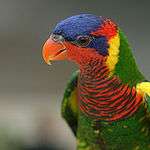 |
25 cm (10.0 in) long. The head is dark blue on top and face below eyes and chin is red. Red at back of the head and yellow on sides of neck. Front of neck to chest has transverse bars of red and blue. Green abdomen with sparse variable yellow scalloping. Beak is orange-red, irises are dark orange, eye-ring is dark grey, and legs are grey.[4] | Sulawesi and surrounding islands[5] |
| Rainbow lorikeet Trichoglossus moluccanus |
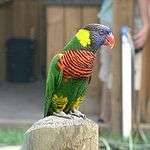 |
Some classifications list about 20 subspecies; although, several are sometimes listed as separate species (see below). The photograph (left) is T. h. haematodus. | Australia, (Introduced to Hong Kong.)[6] |
| Olive-headed lorikeet Trichoglossus euteles |
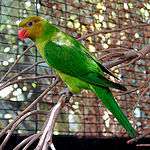 |
24 cm (9.5 in) long. Mainly green with an olive coloured head which is demarcated by a green collar. Its beak is orange-red, its irises are red, and its legs are grey.[4] | Lesser Sundas: Indonesia and Timor-Leste[7] |
| Citrine lorikeet Trichoglossus flavoviridis |
 |
20 cm (8.0 in) long. Mainly green with green and yellow scalloping on its front. Its head is yellow and brown.[4] | Sulawesi, Sulu Islands[8] |
| Mindanao lorikeet Trichoglossus johnstoniae |
-3c.jpg) |
20 cm (8 in) long. Mainly green with yellow transverse striations on its front. Its face is red and there is a dark purple band around its head. There is extensive yellow areas on the lower surface of its wings. Its legs are greenish-grey. The beak is orange, the eye-ring is dark grey, the irises are red.[4] | Mindanao (Philippines)[9] |
| Pohnpei lorikeet Trichoglossus rubiginosus |
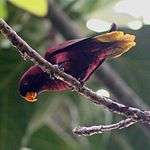 |
24 cm long. It is mainly reddish-maroon with vague approximately transverse striations of darker maroon. The head a slightly darker maroon. The flight feathers and tail are olive-yellow. Its legs are grey. The male has an orange beak and yellow-orange irises, while the female has a yellow beak and light grey irises.[4] | Pohnpei (Micronesia)[10] |
| Scaly-breasted lorikeet Trichoglossus chlorolepidotus |
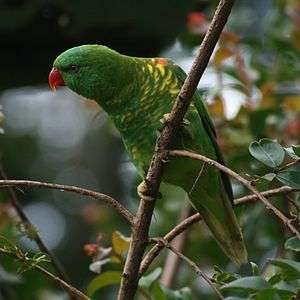 |
23 cm (9.0 in) long. Mainly green with an all green head. Lowerparts are barred with short transverse yellow and green striations. Orange on lower surface of wings.[4] | Eastern Australia[11] |
Rainbow lorikeet species complex
The rainbow lorikeet has about 20 subspecies in some classifications; although, several of these are sometimes split off to form up to four additional species: The parentheses in the scientific names of the birds in the table are used to indicate that a taxon is sometimes considered to be a full species and sometimes listed as a subspecies of the rainbow lorikeet.
| Subspecies of rainbow lorikeet that are sometime classified as separate species | |||
|---|---|---|---|
| Common and binomial names[3] | Image | Description | Range |
| Sunset lorikeet Trichoglossus (haematodus) forsteni |
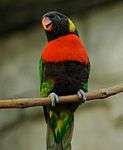 |
Sometimes classified as a subspecies of the rainbow lorikeet | The Indonesian island of Sumbawa, Tanahjampea and Kalaotoa |
| Leaf lorikeet Trichoglossus (haematodus) weberi |
 |
Mostly green. Sometimes classified as a subspecies of the rainbow lorikeet | Flores, one of the Lesser Sunda Islands of Indonesia[12] |
| Marigold lorikeet Trichoglossus (haematodus) capistratus |
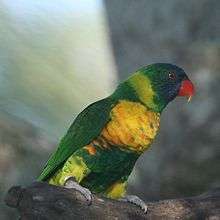 |
Sometimes classified as a subspecies of the rainbow lorikeet | Islands of Sumba, Wetar and Timor in south-east Asia |
| Red-collared lorikeet Trichoglossus (haematodus) rubritorquis |
 |
Sometimes classified as a subspecies of the rainbow lorikeet | Northern Australia, including north Kimberley and North West Queensland, but excluding Far North Queensland.[13] |
References
- ↑ Low, p.69.
- ↑ Liddell, Henry George and Robert Scott (1980). A Greek-English Lexicon (Abridged Edition). United Kingdom: Oxford University Press. ISBN 0-19-910207-4.
- 1 2 3 "Zoological Nomenclature Resource: Psittaciformes (Version 9.020)". www.zoonomen.net. Retrieved 20 March 2009.
- 1 2 3 4 5 6 Forshaw (2006). plate 13.
- ↑ BirdLife International (2014). "Trichoglossus ornatus". IUCN Red List of Threatened Species. Version 2004.3. International Union for Conservation of Nature. Retrieved 4 January 2015.
- ↑ BirdLife International (2014). "Trichoglossus moluccanus". IUCN Red List of Threatened Species. Version 2004.3. International Union for Conservation of Nature. Retrieved 4 January 2015.
- ↑ BirdLife International (2014). "Trichoglossus euteles". IUCN Red List of Threatened Species. Version 2004.3. International Union for Conservation of Nature. Retrieved 4 January 2015.
- ↑ BirdLife International (2014). "Trichoglossus flavoviridis". IUCN Red List of Threatened Species. Version 2004.3. International Union for Conservation of Nature. Retrieved 4 January 2015.
- ↑ BirdLife International (2014). "Trichoglossus johnstoniae". IUCN Red List of Threatened Species. Version 2004.3. International Union for Conservation of Nature. Retrieved 4 January 2015.
- ↑ BirdLife International (2014). "Trichoglossus rubiginosus". IUCN Red List of Threatened Species. Version 2004.3. International Union for Conservation of Nature. Retrieved 4 January 2015.
- ↑ BirdLife International (2014). "Trichoglossus chlorolepidotus". IUCN Red List of Threatened Species. Version 2004.3. International Union for Conservation of Nature. Retrieved 4 January 2015.
- ↑ Forshaw (2006). plate 15.
- ↑ Forshaw (2006). plate 12.
Cited texts
- Forshaw, Joseph M. (2006). Parrots of the World; an Identification Guide. Illustrated by Frank Knight. Princeton University Press. ISBN 0-691-09251-6.
- Low, Rosemary (1978). Lories and Lorikeets. Inkata Press: Melbourne. ISBN 0-909605-08-4.
External links
| Wikimedia Commons has media related to Trichoglossus. |